Convolutional Neural Network Based on Extreme Learning Machine for Maritime Ships Recognition in Infrared Images
Abstract
1. Introduction
2. Proposed Approach
2.1. Pipeline of the Proposed Approach
2.1.1. Features Extraction
2.1.2. Classification
2.2. Extreme Learning Machine Overview
| Algorithm 1 The ELM algorithm. |
| Input: Dataset , target , and the number of hidden nodes L. Output: ELM parameters. Generate randomly the input weights and the bias and . Compute the hidden matrix . Compute the output weights . Return the ELM parameters , , and . |
2.3. ELM Based Ensemble for Classification
| Algorithm 2 Training of the ELM based ensemble for classification. |
| Input: Dataset , target , number of individual models M, and number of hidden nodes L. Output: ELM based ensemble parameters. for M do Generate randomly the input weights and biases and . Compute the hidden matrix . Compute the output weights . Compute the outputs . end for Compute the global hidden matrix . Compute the fusion parameters . Return the ensemble parameters , , , for and . |
2.4. ELM Based Training of Convolutional Neural Network
| Algorithm 3 Training procedure of CONV layer using ELM. |
| Input: Input feature map. Output: CONV parameters: filters and bias . Generate normalized training data . Compute desired target . Generate randomly the input weights and biases and . Compute the hidden matrix . Compute the output weights . Compute filters and bias . Reshape the filters matrix . Return CONV parameters and . |
3. Experimental Results
3.1. Experimental Settings
3.1.1. VAIS Dataset
3.1.2. Data Pre-Processing
3.1.3. CNN Architectures
3.1.4. Simulation Environment
3.2. Evaluation of Features Extraction Component
3.2.1. Settings
3.2.2. Results
3.2.3. Features Fusion Results
3.3. Evaluation of the Classification Component
3.4. Evaluation of the Proposed Approach
4. Discussion
4.1. The ELM-CNN Approach
4.2. The ELM Based Ensemble
4.3. The Proposed Approach
5. Conclusions
Author Contributions
Acknowledgments
Conflicts of Interest
References
- Zhang, M.M.; Choi, J.; Daniilidis, K.; Wolf, M.T.; Kanan, C. VAIS: A dataset for recognizing maritime imagery in the visible and infrared spectrums. In Proceedings of the 2015 IEEE Conference on Computer Vision and Pattern Recognition Workshops (CVPRW), Boston, MA, USA, 7–12 June 2015; pp. 10–16. [Google Scholar]
- Withagen, P.J.; Schutte, K.; Vossepoel, A.M.; Breuers, M.G. Automatic classification of ships from infrared (FLIR) images. In Signal Processing, Sensor Fusion, and Target Recognition VIII; International Society for Optics and Photonics: Washington, DC, USA, 1999; Volume 3720, pp. 180–188. [Google Scholar]
- Teutsch, M.; Krüger, W. Classification of small boats in infrared images for maritime surveillance. In Proceedings of the International Waterside Security Conference (WSS), Carrara, Italy, 3–5 November 2010; pp. 1–7. [Google Scholar]
- Krizhevsky, A.; Sutskever, I.; Hinton, G.E. ImageNet Classification with Deep Convolutional Neural Networks. In Advances in Neural Information Processing Systems 25; Pereira, F., Burges, C.J.C., Bottou, L., Weinberger, K.Q., Eds.; Curran Associates, Inc.: New York, NY, USA, 2012; pp. 1097–1105. [Google Scholar]
- Russakovsky, O.; Deng, J.; Su, H.; Krause, J.; Satheesh, S.; Ma, S.; Huang, Z.; Karpathy, A.; Khosla, A.; Bernstein, M.; et al. ImageNet Large Scale Visual Recognition Challenge. Int. J. Comput. Vis. 2015, 115, 211–252. [Google Scholar] [CrossRef]
- Khellal, A.; Ma, H.; Fei, Q. Pedestrian Classification and Detection in Far Infrared Images. In Intelligent Robotics and Applications; Springer: Cham, Switzerland, 2015; pp. 511–522. [Google Scholar]
- John, V.; Mita, S.; Liu, Z.; Qi, B. Pedestrian detection in thermal images using adaptive fuzzy C-means clustering and convolutional neural networks. In Proceedings of the 14th IAPR International Conference on Machine Vision Applications (MVA), Tokyo, Japan, 18–22 May 2015; pp. 246–249. [Google Scholar]
- Kim, J.H.; Hong, H.G.; Park, K.R. Convolutional Neural Network-Based Human Detection in Nighttime Images Using Visible Light Camera Sensors. Sensors 2017, 17, 1065. [Google Scholar] [CrossRef]
- An, Q.; Pan, Z.; You, H. Ship Detection in Gaofen-3 SAR Images Based on Sea Clutter Distribution Analysis and Deep Convolutional Neural Network. Sensors 2018, 18, 334. [Google Scholar] [CrossRef] [PubMed]
- Huang, G.B.; Zhu, Q.Y.; Siew, C.K. Extreme learning machine: A new learning scheme of feedforward neural networks. In Proceedings of the 2004 IEEE International Joint Conference on Neural Networks, Budapest, Hungary, 25–29 July 2004; Volume 2, pp. 985–990. [Google Scholar]
- Huang, G.B.; Zhu, Q.Y.; Siew, C.K. Extreme learning machine: Theory and applications. Neurocomputing 2006, 70, 489–501. [Google Scholar] [CrossRef]
- Kasun, L.L.C.; Zhou, H.; Huang, G.B.; Vong, C.M. Representational learning with ELMs for big data. IEEE Intell. Syst. 2013, 28, 31–34. [Google Scholar]
- Yoo, Y.; Oh, S.Y. Fast training of convolutional neural network classifiers through extreme learning machines. In Proceedings of the International Joint Conference on Neural Networks (IJCNN), Vancouver, BC, Canada, 24–29 July 2016; pp. 1702–1708. [Google Scholar]
- Bartlett, P.L. The sample complexity of pattern classification with neural networks: The size of the weights is more important than the size of the network. IEEE Trans. Inf. Theory 1998, 44, 525–536. [Google Scholar] [CrossRef]
- Huang, G.B.; Chen, L.; Siew, C.K. Universal approximation using incremental constructive feedforward networks with random hidden nodes. IEEE Trans. Neural Netw. 2006, 17, 879–892. [Google Scholar] [CrossRef] [PubMed]
- Vedaldi, A.; Lenc, K. MatConvNet—Convolutional Neural Networks for MATLAB. In Proceeding of the 2015 ACM Multimedia Conference, Brisbane, Australia, 26–30 October 2015. [Google Scholar]
- Fan, R.E.; Chang, K.W.; Hsieh, C.J.; Wang, X.R.; Lin, C.J. LIBLINEAR: A Library for Large Linear Classification. J. Mach. Learn. Res. 2008, 9, 1871–1874. [Google Scholar]
- Hansen, L.K.; Salamon, P. Neural network ensembles. IEEE Trans. Pattern Anal. Mach. Intell. 1990, 12, 993–1001. [Google Scholar] [CrossRef]
- Lan, Y.; Soh, Y.C.; Huang, G.B. Ensemble of online sequential extreme learning machine. Neurocomputing 2009, 72, 3391–3395. [Google Scholar] [CrossRef]
- Simonyan, K.; Zisserman, A. Very Deep Convolutional Networks for Large-Scale Image Recognition. arXiv, 2014; arXiv:1409.1556. [Google Scholar]
- Maaten, L.V.D.; Hinton, G. Visualizing data using t-SNE. J. Mach. Learn. Res. 2008, 9, 2579–2605. [Google Scholar]

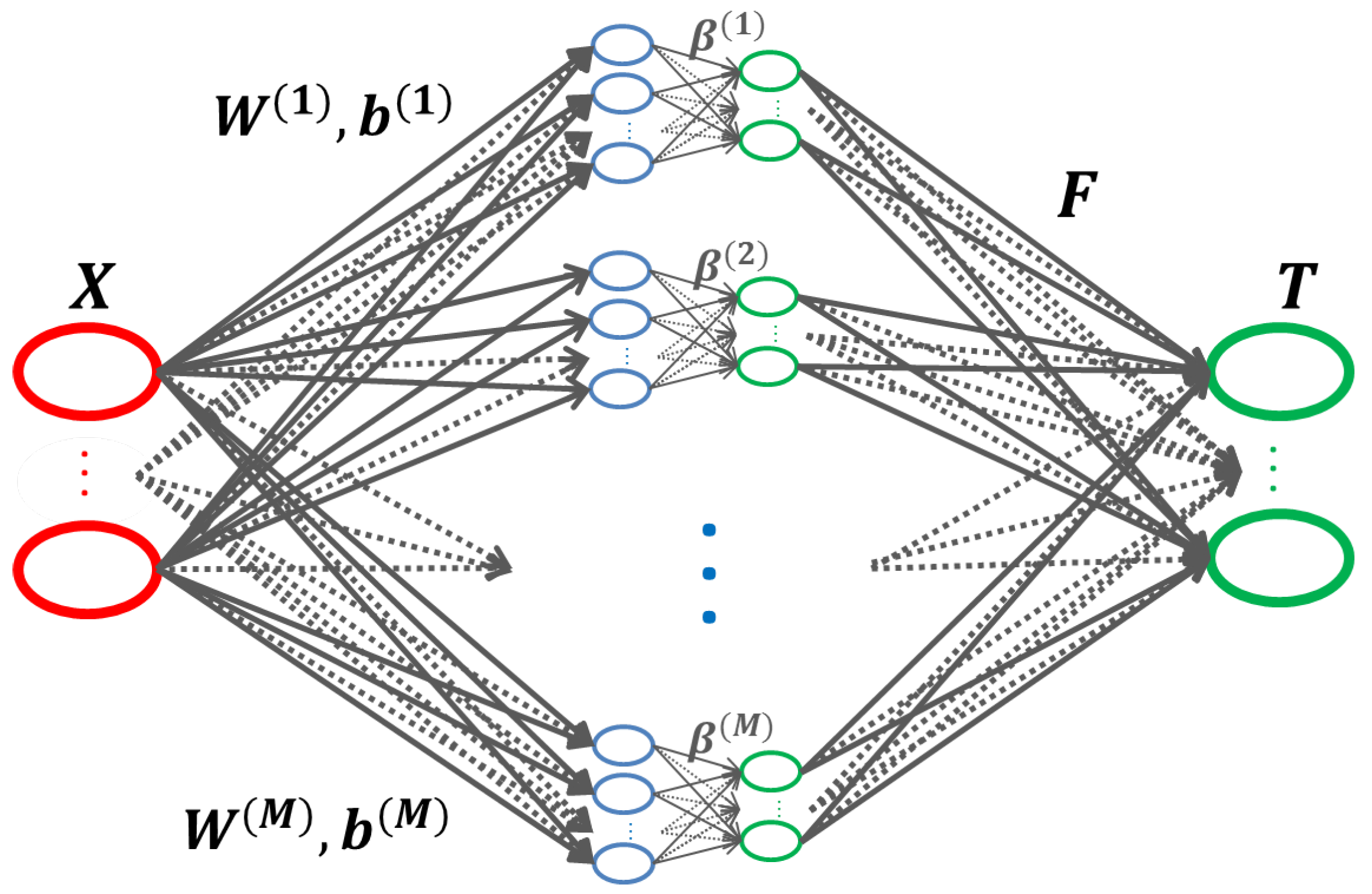
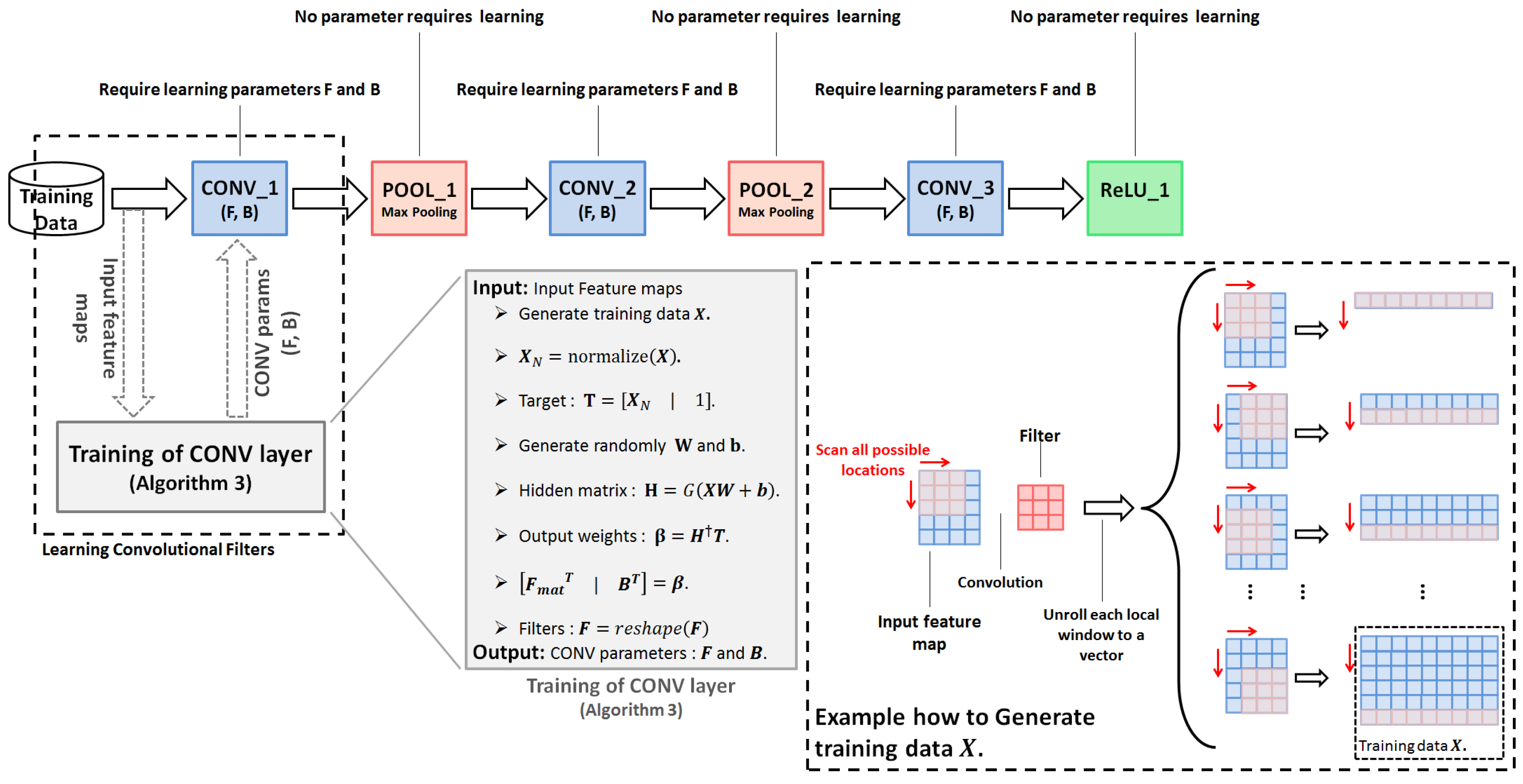

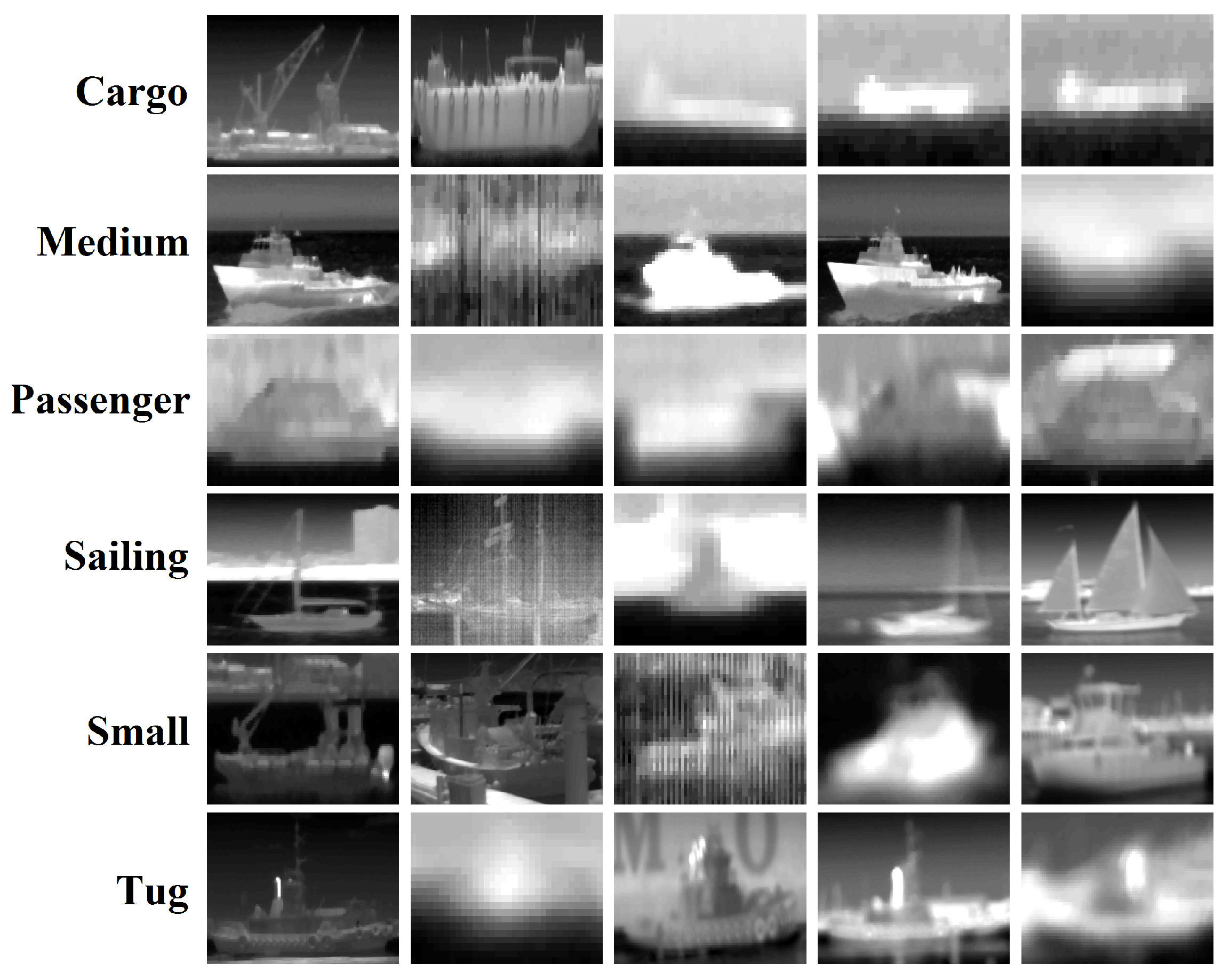
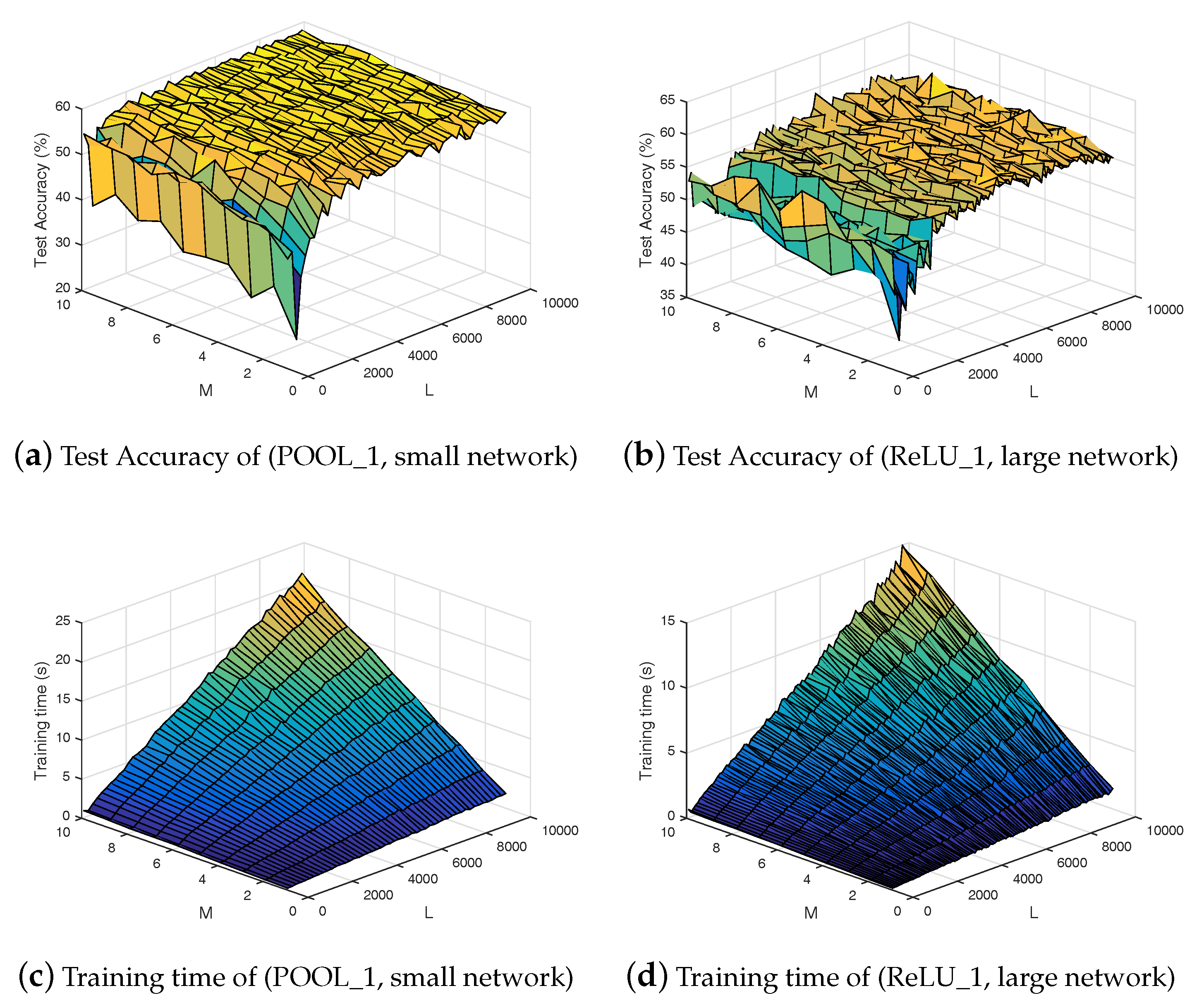
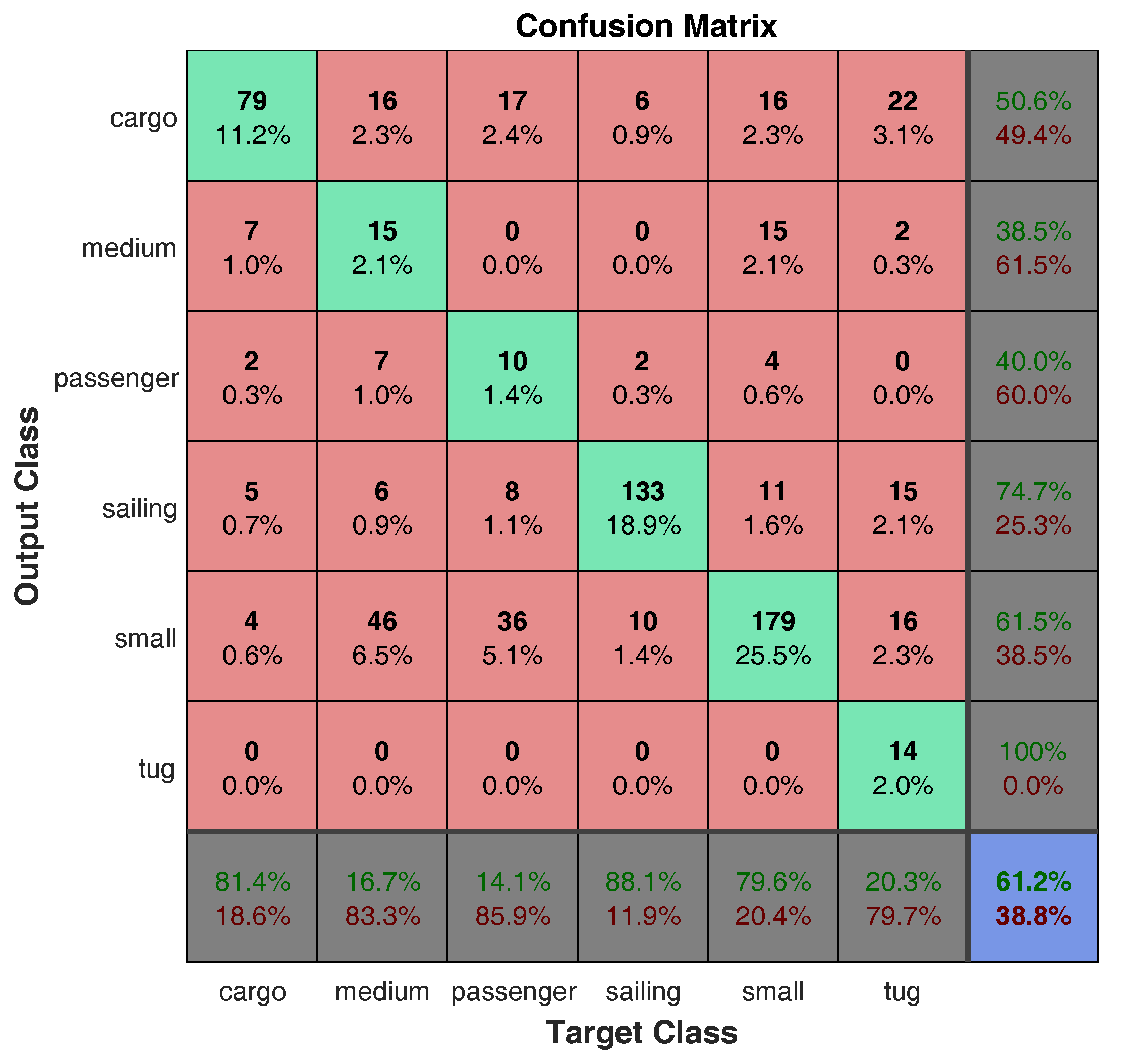
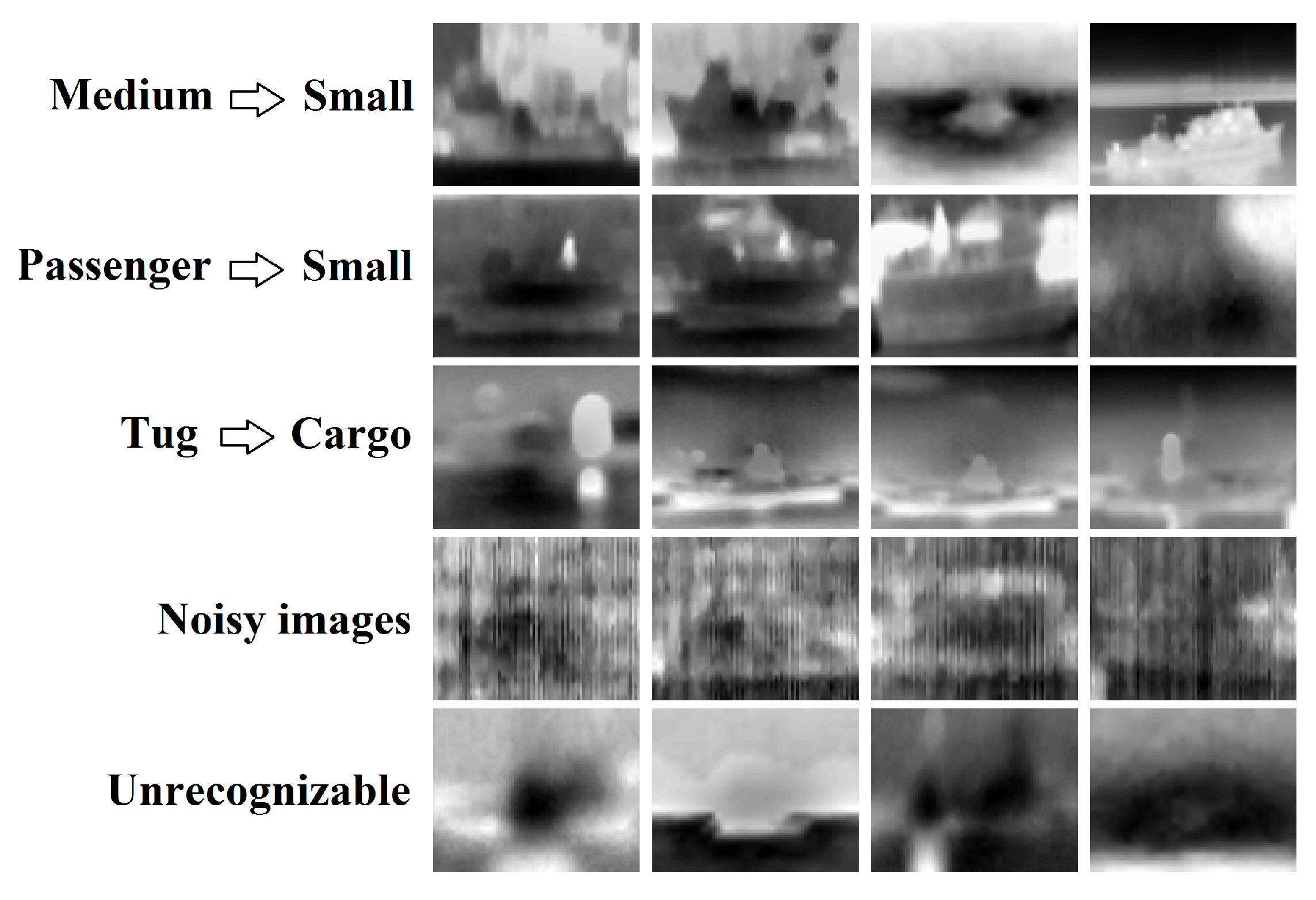
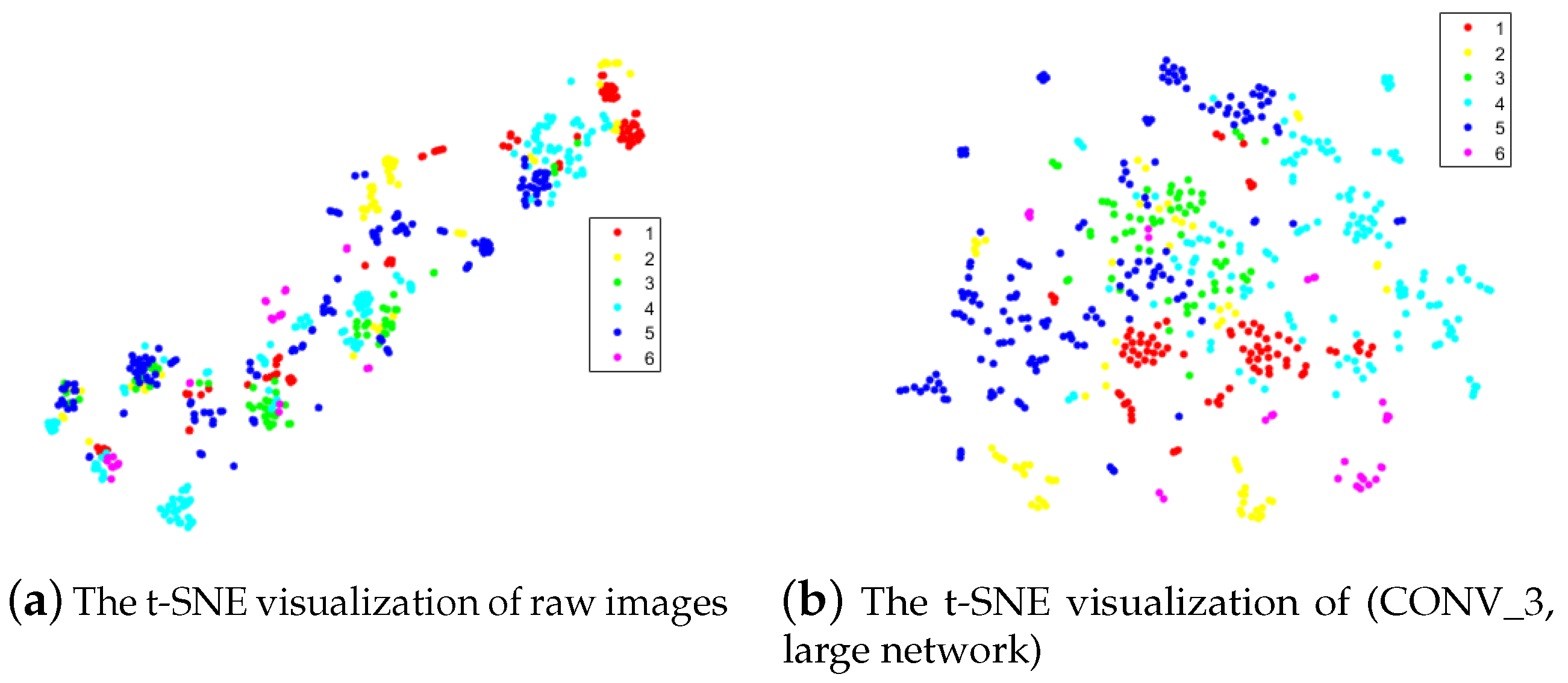
| Layers | Parameters (Small CNN) | Parameters (Large CNN) |
|---|---|---|
| CONV_1 | Filters: | Filters: |
| Stride: 2 | Stride: 2 | |
| POOL_1 | Method: max | Method: max |
| Size: | Size: | |
| Stride: 2 | Stride: 2 | |
| CONV_2 | Filters: | Filters: |
| Stride: 2 | Stride: 2 | |
| POOL_2 | Method: max | Method: max |
| Size: | Size: | |
| Stride: 2 | Stride: 2 | |
| CONV_3 | Filters: | Filters: |
| Stride: 1 | Stride: 1 | |
| ReLU_1 | Rectified Linear Unit | Rectified Linear Unit |
| CONV_4 | Filters: | Filters: |
| (FC) | Stride: 1 | Stride: 1 |
| Test Accuracy (%) | Training Time (s) | |||
|---|---|---|---|---|
| Features | BP-CNN | ELM-CNN | BP-CNN | ELM-CNN |
| POOL_1 | 53.34 | 57.04 | 4608.7 | 4.8109 |
| CONV_2 | 53.49 | 54.91 | 4608.7 | 16.2552 |
| POOL_2 | 54.62 | 54.20 | 4608.7 | 17.3252 |
| CONV_3 | 55.19 | 57.18 | 4608.7 | 28.3843 |
| ReLU_1 | 50.92 | 57.33 | 4608.7 | 30.8163 |
| Test Accuracy (%) | Training Time (s) | |||
|---|---|---|---|---|
| Features | BP-CNN | ELM-CNN | BP-CNN | ELM-CNN |
| POOL_1 | 52.06 | 57.33 | 151.09 | 1.2149 |
| CONV_2 | 54.77 | 52.77 | 151.09 | 2.1981 |
| POOL_2 | 52.20 | 58.75 | 151.09 | 2.2708 |
| CONV_3 | 51.78 | 55.48 | 151.09 | 2.6187 |
| ReLU_1 | 51.49 | 55.48 | 151.09 | 2.7779 |
| Test Accuracy (%) | Training Time (s) | |||
|---|---|---|---|---|
| Features | BP-CNN | ELM-CNN | BP-CNN | ELM-CNN |
| POOL_1 | 98.27 | 98.36 | 767.45 | 46.90 |
| CONV_2 | 98.01 | 97.53 | 767.45 | 118.88 |
| POOL_2 | 98.97 | 98.54 | 767.45 | 132.49 |
| CONV_3 | 98.84 | 97.53 | 767.45 | 145.33 |
| ReLU_1 | 99.16 | 98.09 | 767.45 | 157.08 |
| Features | POOL_1 | CONV_2 | POOL_2 | CONV_3 | ReLU_1 |
|---|---|---|---|---|---|
| POOL_1 | 55.33 | 51.92 | 54.48 | 51.92 | 51.92 |
| CONV_2 | 57.18 | 52.77 | 54.05 | 52.92 | 52.63 |
| POOL_2 | 54.48 | 54.05 | 58.75 | 53.63 | 53.91 |
| CONV_3 | 51.92 | 52.92 | 53.63 | 54.62 | 55.19 |
| ReLU_1 | 51.92 | 52.63 | 53.49 | 55.33 | 55.48 |
| Datasets | # Atrrib | # Classes | # Train | # Test |
|---|---|---|---|---|
| Balance | 4 | 3 | 400 | 225 |
| DNA | 180 | 3 | 1400 | 1186 |
| Duke | 7129 | 2 | 29 | 15 |
| Hill | 100 | 2 | 606 | 606 |
| Sonar | 60 | 2 | 150 | 58 |
| Vais | 6241 | 6 | 539 | 703 |
| Waveform | 21 | 3 | 3000 | 2000 |
| Datasets | SVM | KNN | DT | Boosted DT | Bagged DT | ELM Based Ensemble | ||||||
|---|---|---|---|---|---|---|---|---|---|---|---|---|
| Accuracy | Time | Accuracy | Time | Accuracy | Time | Accuracy | Time | Accuracy | Time | Accuracy | Time | |
| Balance | ||||||||||||
| DNA | ||||||||||||
| Duke | ||||||||||||
| Hill | ||||||||||||
| Sonar | ||||||||||||
| Vais | ||||||||||||
| Waveform | ||||||||||||
| Approaches | Test Accuracy (%) | M | L |
|---|---|---|---|
| Gnostic Field [1] | 57.21 | - | - |
| CNN [1] | 55.29 | - | - |
| Gnostic Field + CNN [1] | 57.72 | - | - |
| POOL_2 (Large Net) | 56.76 | 6 | 100 |
| CONV_3 (Large Net) | 61.17 | 1 | 9000 |
| ReLU_1 (Large Net) | 60.73 | 8 | 9000 |
| POOL_1 (Small Net) | 59.60 | 8 | 2900 |
| POOL_2 (Small Net) | 58.03 | 4 | 100 |
| ReLU_1 (Small Net) | 57.89 | 3 | 10900 |
© 2018 by the authors. Licensee MDPI, Basel, Switzerland. This article is an open access article distributed under the terms and conditions of the Creative Commons Attribution (CC BY) license (http://creativecommons.org/licenses/by/4.0/).
Share and Cite
Khellal, A.; Ma, H.; Fei, Q. Convolutional Neural Network Based on Extreme Learning Machine for Maritime Ships Recognition in Infrared Images. Sensors 2018, 18, 1490. https://doi.org/10.3390/s18051490
Khellal A, Ma H, Fei Q. Convolutional Neural Network Based on Extreme Learning Machine for Maritime Ships Recognition in Infrared Images. Sensors. 2018; 18(5):1490. https://doi.org/10.3390/s18051490
Chicago/Turabian StyleKhellal, Atmane, Hongbin Ma, and Qing Fei. 2018. "Convolutional Neural Network Based on Extreme Learning Machine for Maritime Ships Recognition in Infrared Images" Sensors 18, no. 5: 1490. https://doi.org/10.3390/s18051490
APA StyleKhellal, A., Ma, H., & Fei, Q. (2018). Convolutional Neural Network Based on Extreme Learning Machine for Maritime Ships Recognition in Infrared Images. Sensors, 18(5), 1490. https://doi.org/10.3390/s18051490




